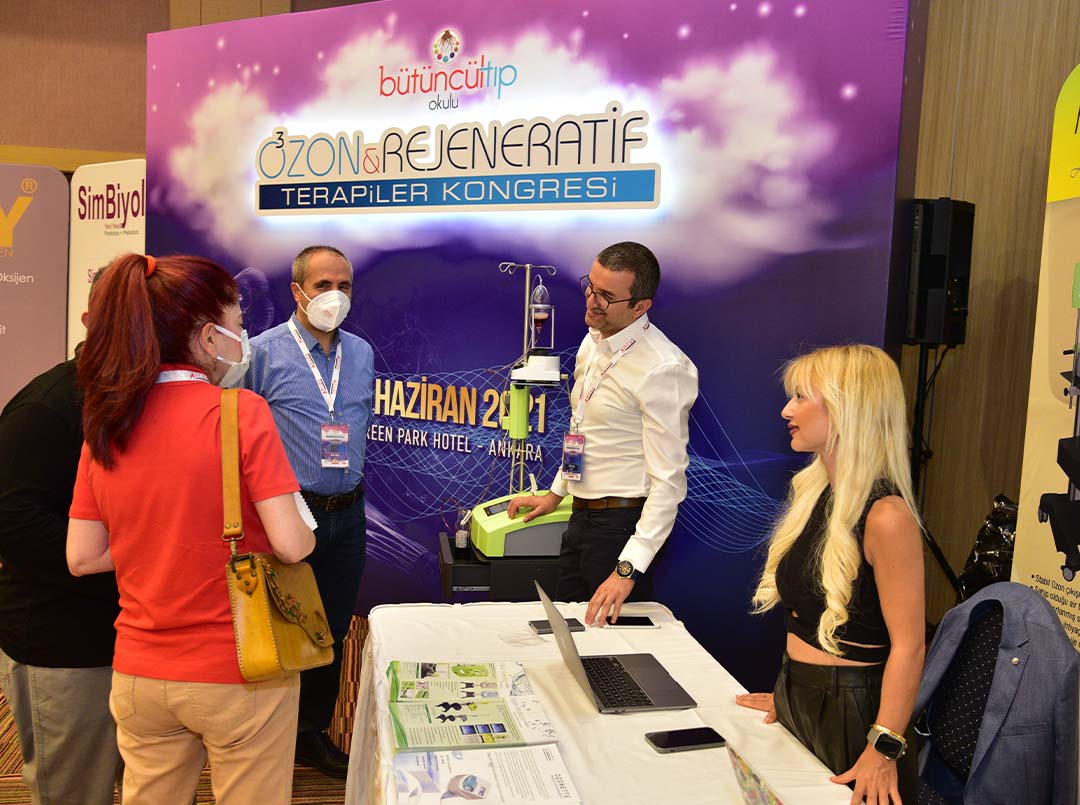 OZONE THERAPY
OZONE THERAPY
Ozone gas is a high-energy form of oxygen consisting of three oxygen atoms (O³). It is a colorless gas with a characteristic odor and is found in the atmosphere, protecting the biosphere by providing a protective filter against ultraviolet rays emitted by the sun. Ozone has been used to disinfect water and in various industries. In the medical field, ozone is produced in special generators from pure oxygen and is used as an auxiliary treatment method in diseases where the immune system is at the forefront. These diseases are wound healing, ischemic, rheumatic and infectious diseases. Ozone therapy is usually administered by intravenous or subcutaneous injection.
Reactive oxygen species cause oxidative damage to cells due to age. This condition is called increased oxidative stress. In recent studies, it has been shown that the products produced by administering ozone to the body together with low doses of reactive oxygen play a role in biological mechanisms, especially intracellular communication, in low amounts (at physiological levels) and mediate therapeutic effects. As a result of repeated low-dose ozone applications, the antioxidant system is strengthened and resistance to oxidative stress develops.
In addition, reactive oxygen species enter the cell and increase the production of cytokine levels and growth factors that reduce inflammation. Ozone therapy is used as an auxiliary treatment method, especially in diseases where the inflammatory process is intense and the immune system is at the forefront (wound healing, ischemic, rheumatic and infectious diseases).
It accelerates cell regeneration.
Ozone eliminates oxygen deficiency by increasing the oxygen carrying capacity, elasticity and fluidity of the red blood cells. It is also applied as an adjunctive treatment in cases of vascular occlusion and enlargement of the veins.
It directly interacts with fat cells, causing a decrease in cholesterol and regional fat breakdown.
It lowers blood sugar level.
It reduces cartilage loss in arthritis and by stimulating the production of intra-articular fluids and cartilage, it reduces joint pain and increases mobility.
In addition, the advantages and benefits of ozone therapy include:
Antioxidant effect: Ozone gas has antioxidant properties and fights free radicals. Therefore, ozone therapy can protect the body from damage caused by free radicals.
Supports the immune system: Ozone therapy strengthens the immune system and increases the body's ability to fight infections.
Increases blood circulation: Ozone therapy increases blood circulation and helps to carry more oxygen and nutrients to the tissues. This can accelerate the healing of tissues.
Anti-inflammatory effect: Ozone therapy can reduce inflammation and alleviate health problems associated with chronic inflammation.
Reduces pain: Ozone therapy can reduce pain and can be used in the treatment of chronic pain.
Diseases Benefiting from Ozone Therapy
Osteomyelitis, pleural emphysema, fistula abscesses, infected wounds, pressure sores, chronic ulcers, diabetic feet and burns
Hypertension
Diabetes (Diabetes)
advanced ischemic diseases,
Eye macular degeneration (atrophic form), Musculoskeletal diseases and joint calcifications
Chronic fatigue syndrome and fibromyalgia
Chronic and recurrent infections and sores in the oral cavity
Acute and chronic infectious diseases (hepatitis, HIV-AIDS, herpes and herpes zoster infection, papillomavirus infections, onychomycosis and candidiasis, giardiasis and cryptosporidiosis), especially caused by bacteria, viruses, fungi resistant to antibiotics and chemical treatments. Baroclinitis and vaginal candidiasis.
Allergy and Asthma
Autoimmune diseases (multiple sclerosis, rheumatoid arthritis, Crohn's disease),
Senile dementia (senile dementia)
Lung diseases: emphysema, chronic obstructive pulmonary disease, idiopathic pulmonary fibrosis and acute respiratory stress syndrome
Skin diseases: Psoriasis (Psoriasis) and atopic dermatitis
Cancer-related fatigue
early stage kidney failure
What are the Treatment Methods?
Major Autohemotherapy: It is the most common method of use. With this method, 50-200 ml of blood taken from the person, the number of treatment sessions and the ozone dose to be applied; It will depend on the patient's general condition, age, and major illness.
Minor Autohemotherapy: 2 – 5 cc of blood taken from the person is mixed with ozone at the specified dose and injected into the person.
Giving Ozone to Body Cavities: Ozone is given to the person by spraying rectal – rectal, vaginal and ear canal.
Giving Ozone Gas to the Joints and Muscles: In musculoskeletal disorders, a certain dose of ozone gas is injected into the joints and muscles of the person with an appropriate needle.
Ozone Bagging: It is used in non-healing wounds and diabetic feet, skin lesions, infections, circulatory disorders, neuropathic pain and restless legs syndrome.
Side Effects of Ozone Therapy
Ozone therapy has almost no side effects. Side effects reported so far may develop due to application errors and high-dose ozone administration depending on the antioxidant capacity of the patient. For this reason, ozone therapy should always be applied gradually and gradually, starting with a low dose and increasing gradually. In some cases, the application of ozone therapy may be inconvenient. These conditions can be listed as glucose 6 phosphate dehydrogenase enzyme deficiency, especially early pregnancy, angiotensin converting enzyme (ACE) inhibitor therapy, hyperthyroidism, bleeding disorder, uncontrolled cardiovascular diseases and asthma patients responding to ozone.



